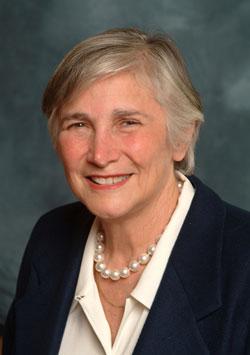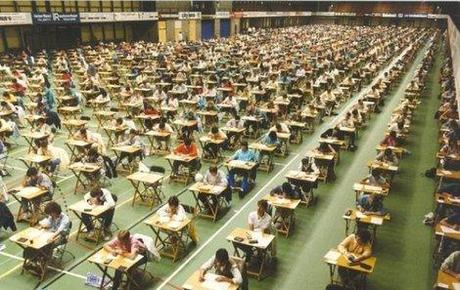
Diane Ravitch
By Alan Bean
The pioneer and perfecter of the current passion for evaluating teachers on the basis of student performance on standardized tests can be laid at the feet of Eric Hanushek, a Stanford professor. Hanushek believes that bad teachers beget bad students. Ergo, if you want successful students, fire bad teachers.
No one questions that good teachers are better than bad teachers; but is testing an effective way to tell the difference. As Diane Ravitch explains below, good teachers who work in poor schools test badly. Since schools in affluent areas have fewer disciplinary problems and higher rates of student achievement, teachers find them desirable. Poor schools get teachers with an unusually keen sense of mission or, more often, teachers who were passed over by principals in more affluent schools.
Hanushek is celebrated because he ignores poverty. You can’t improve public education by throwing money at the problem, he believes. Students don’t do badly because they come from poor neighborhoods; they perform badly because they have bad teachers. Fire the worst 10% of any given faculty and the achievement gap between poor and affluent kids disappears.
In states like Texas, this kind of thinking has become gospel. No Child Left Behind was build on Hanushek’s “research” and the Obama administration, for all his criticism of teaching to the test, embraces the same weary logic. Recently, the Gates and Walton Foundations have jumped on the fire-the-baddies bandwagon.
But there’s a problem: the evidence suggests otherwise.
Researchers who site poverty as the key factor influencing student performance are ignored. In a time of fiscal conservatism they speak an inconvenient truth. Diane Ravitch is that kind of researcher; a voice crying in the American wilderness. She reminds me of the little boy addressing the obvious fact that the Emperor is naked. Please give this article in the New York Review of Books a careful read. You may also want to check out her blistering critique of Dr. Hanushek here.
No Student Left Untested
Diane Ravitch

Last week, the New York State Education Department and the teachers’ unions reached an agreement to allow the state to use student test scores to evaluate teachers. The pact was brought to a conclusion after Governor Andrew Cuomo warned the parties that if they didn’t come to an agreement quickly, he would impose his own solution (though he did not explain what that would be). He further told school districts that they would lose future state aid if they didn’t promptly implement the agreement after it was released to the public. The reason for this urgency was to secure $700 million promised to the state by the Obama administration’s Race to the Top program, contingent on the state’s creating a plan to evaluate teachers in relation to their students’ test scores.
The new evaluation system pretends to be balanced, but it is not. Teachers will be ranked on a scale of 1-100. Teachers will be rated as “ineffective, developing, effective, or highly effective.” Forty percent of their grade will be based on the rise or fall of student test scores; the other sixty percent will be based on other measures, such as classroom observations by principals, independent evaluators, and peers, plus feedback from students and parents.
But one sentence in the agreement shows what matters most: “Teachers rated ineffective on student performance based on objective assessments must be rated ineffective overall.” What this means is that a teacher who does not raise test scores will be found ineffective overall, no matter how well he or she does with the remaining sixty percent. In other words, the 40 percent allocated to student performance actually counts for 100 percent. Two years of ineffective ratings and the teacher is fired.
The New York press treated the agreement as a major breakthrough that would lead to dramatic improvement in the schools. The media assumed that teachers and principals in New York State would now be measured accurately, that the bad ones would be identified and eventually ousted, and that the result would be big gains in test scores. Only days earlier, a New York court ruled that the media will be permitted to publish the names and rankings of teachers in New York City, even if the rankings are inaccurate. Thus, the scene has been set: Not only will teachers and principals be rated, but those ratings can now be released to the public online and in the press.
The consequences of these policies will not be pretty. If the way these ratings are calculated is flawed, as most testing experts acknowledge they are, then many good educators will be subject to public humiliation and will leave the profession. Once those scores are released to the media, we can expect that parents will object if their children are assigned to “bad” teachers, and principals will have a logistical nightmare trying to squeeze most children into the classes of the highest-ranked teachers. Will parents sue if their children do not get the “best” teachers?
New York’s education officials are obsessed with test scores. The state wants to find and fire the teachers who aren’t able to produce higher test scores year after year. But most testing experts believe that the methods for calculating teachers’ assumed “value-added” qualities—that is, their abilities to produce higher test scores year after year—are inaccurate, unstable, and unreliable. Teachers in affluent suburbs are likelier to get higher value-added scores than teachers of students with disabilities, students learning English, and students from extreme poverty. All too often, the rise or fall of test scores reflects the composition of the classroom and factors beyond the teachers’ control, not the quality of the teacher. A teacher who is rated effective one year may well be ineffective the next year, depending on which students are assigned to his or her class.
The state is making a bet that threatening to fire and publicly humiliate teachers it deems are underperforming will be sufficient to produce higher test scores. Since most teachers in New York do not teach tested subjects (reading and mathematics in grades 3-8), the state will require districts to create measures for everything that is taught (called, in state bureaucratese, “student learning objectives”) for all the others. So, in the new system, there will be assessments in every subject, including the arts and physical education. No one knows what those assessments will look like. Everything will be measured, not to help students, but to evaluate their teachers. If the district’s own assessments are found to be not sufficiently rigorous by State Commissioner of Education John King (who has only three years of teaching experience, two in charter schools), he has the unilateral power to reject them.
This agreement will certainly produce an intense focus on teaching to the tests. It will also profoundly demoralize teachers, as they realize that they have lost their professional autonomy and will be measured according to precise behaviors and actions that have nothing to do with their own definition of good teaching. Evaluators will come armed with elaborate rubrics identifying precisely what teachers must do and how they must act, if they want to be successful. The New York Times interviewed a principal in Tennessee who felt compelled to give a low rating to a good teacher, because the teacher did not “break students into groups” in the lesson he observed. The new system in New York will require school districts across the state to hire thousands of independent evaluators, as well as create much additional paperwork for principals. Already stressed school budgets will be squeezed further to meet the pact’s demands for monitoring and reporting.
President Obama said in his State of the Union address that teachers should “stop teaching to the test,” but his own Race to the Top program is the source of New York’s hurried and wrong-headed teacher evaluation plan. According to Race to the Top, states are required to evaluate teachers based in part on their students’ test scores in order to compete for federal funding. When New York won $700 million from the Obama program, it pledged to do this. What the President has now urged (“stop teaching to the test”) is directly contradicted by what his own policies make necessary (teach to the test or be rated ineffective and get fired).
No high-performing nation in the world evaluates teachers by the test scores of their students; and no state or district in this nation has a successful program of this kind. The State of Tennessee and the city of Dallas have been using some type of test-score based teacher evaluation for twenty years but are not known as educational models. Across the nation, in response to the prompting of Race to the Top, states are struggling to evaluate their teachers by student test scores, but none has figured it out.
All such schemes rely on standardized tests as the ultimate measure of education. This is madness. The tests have some value in measuring basic skills and rote learning, but their overuse distorts education. No standardized test can accurately measure the quality of education. Students can be coached to guess the right answer, but learning this skill does not equate to acquiring facility in complex reasoning and analysis. It is possible to have higher test scores and worse education. The scores tell us nothing about how well students can think, how deeply they understand history or science or literature or philosophy, or how much they love to paint or dance or sing, or how well prepared they are to cast their votes carefully or to be wise jurors.
Of course, teachers should be evaluated. They should be evaluated by experienced principals and peers. No incompetent teacher should be allowed to remain in the classroom. Those who can’t teach and can’t improve should be fired. But the current frenzy of blaming teachers for low scores smacks of a witch-hunt, the search for a scapegoat, someone to blame for a faltering economy, for the growing levels of poverty, for widening income inequality.
For a decade, the Bush-era federal law called No Child Left Behind has required the nation’s public schools to test every student in grades 3-8 in reading and mathematics. Now, the Obama administration is pressuring the states to test every grade and every subject. No student will be left untested. Every teacher will be judged by his or her students’ scores. Cheating scandals will proliferate. Many teachers will be fired. Many will leave teaching, discouraged by the loss of their professional autonomy. Who will take their place? Will we ever break free of our national addiction to data? Will we ever stop to wonder if the data mean anything important? Will education survive school reform?
